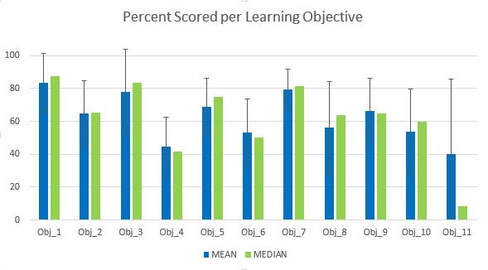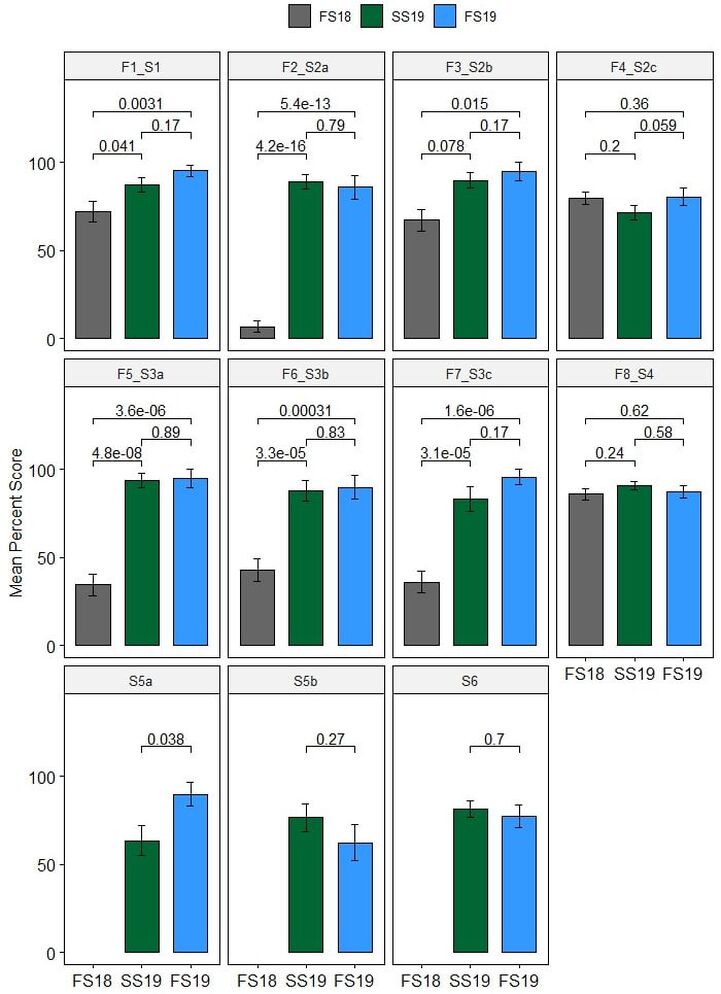An active learning activity for teaching microbial biogeography.
MMG425 - Microbial Ecology
|
This course is an upper level specialty course required for microbiology majors and engineering majors that opt into the environmental microbiology or ecosystem engineering tracks, respectively. It is available as an elective for other majors. Students are mostly juniors and seniors from microbiology and engineering majors. The class meets for 80 minute lecture sessions twice a week.
We analyzed data from three semesters: FS18, SS19, and FS19, where FS18 was pre-intervention, SS19 was the first version of the intervention, and FS19 was a revised and improved version of the activity, based on SS19 student feedback. The Goal & QuestionThe MMG425 FS18 final exam showed that students performed below average on questions related to microbial biogeography (Fig 1, Obj_4). We saw this as an indication that students needed practice applying and integrating biogeography lecture concepts with the other course topics. My question was: do students perform better on biogeography exam questions after completing an active learning exercise?
|
Figure 1 - FS18 Exam Scores by Learning Objective
Blue bars indicate mean percent score, error bars are standard deviation, and green bars indicate median percent score. N = 58 students |
The Pedagogy
I used experiential, integrative, collaborative, and reflective learning theories and guidelines in designing this active learning group exercise. Experiential learning is the process of learning by experience, usually in the form of “hands-on” application of knowledge. Integrative teaching aims to span multiple learning modalities and the interdisciplinary backgrounds of the students. This is crucial to successful collaborative learning, in which students work together in their groups and the larger class community to synthesize and share their knowledge. Finally, we will ask them to reflect on their experience with this active learning exercise and provide feedback for future implementations. These three approaches are all fundamental to constructivist learning theory, which posits that students construct meaning based on their previous knowledge and experience. Instructor awareness, sensitivity, and adaptation to the student’s “come from” is vital to identifying and correcting student misconceptions and misunderstandings. Moreover, an instructor can leverage the insights of students from backgrounds different to their own to provide a new perspective or model of the learning topic. MMG425 students work in diverse groups of 4-5 students assigned using CATME. Students worked in their assigned groups on several projects and activities throughout the course to encourage collaboration and integration of their individual understandings of the material. This exercise now extends those learning approaches to this particular course topic.
The Intervention
Dr. Shade recorded the biogeography lecture as an online pre-class video in a flipped classroom style. During the in-class session, student groups collaboratively completed a worksheet that guided them through a hands-on simulation and data collection using colored pompoms representing microbial taxa. Each group was given an "environment" with different parameters for pH and Carbon, Nitrogen, and water availability. Students modeled how their randomly selected "microbes" died, survived, or thrived in their group's environment. To practice interpreting and visualizing data, students combined and analyzed their data summarizing the environmental conditions (pH, Carbon, etc.) and distribution of microbial taxa. They placed each taxon on an axis ranging from endemic to cosmopolitan, requiring an understanding of these terms and the variable that these terms describe (occupancy). They then used the abundance data to predict where specific taxa would fall on an abundance-occupancy graph and whether they conformed to the neutral model. Finally, they qualified their confidence in their projections based on the sampling depth and perceived abundances (are rare taxa really cosmopolitan/endemic, or just rare?). These follow-up questions were discussed among the whole class to encourage groups to collaborate and to compare their responses, elaborating on differing answers to ensure students understood the spectrum of correct answers (where applicable) and the key distinctions underlying a correct answer versus an incorrect one. The worksheets were not graded, but I provided feedback on their answers and a completed key to support student exam preparation.
Based on our observations of the first implementation of the worksheet in SS19, we revised the worksheet for use in FS19. In particular, we clarified the instructions for the simulation and reorganized some of the follow-up questions in the worksheet.
Based on our observations of the first implementation of the worksheet in SS19, we revised the worksheet for use in FS19. In particular, we clarified the instructions for the simulation and reorganized some of the follow-up questions in the worksheet.
|
| ||||||||||||
Assessments
Observation
Throughout the activity, Dr. Shade and I circulated around the room, listening to groups as they progressed through the simulation and the worksheet. This ensured that we were close at hand if groups needed help with the simulation or a particular discussion question. It also allowed us to observe the group dynamics and student engagement with the material, gauging whether students seemed to be frustrated, confused, or enjoying the exercise.
Student Feedback
At the end of the activity, we collected Post-It Notes on which students anonymously responded to two prompts:
- What increased your understanding?
- What are you still confused about?
Exam Performance
Several exam questions unaffected by the intervention were used to directly compare student performance between semesters. This allowed us to decide whether we needed to adjust the scores on exam questions related to the intervention to compare changes in performance between semesters. Some of the exam questions related to the intervention were revised, primarily due to the generation of two versions of the exam to minimize cheating. This meant that some of the exam questions from FS18 were seen by only half of the class in SS19 or FS19.
Conclusions
Most students seemed very engaged in the activity, especially in SS19, and reported increased understanding of key concepts after the exercise. We incorporated SS19 student Post-It feedback and our observations to improve and clarify the activity. Dr. Shade also used the post-it feedback to inform which points might need additional clarification at the start of the next lecture, a time she uses to recap previous material and orient students before the next lecture begins.
Student performance on most biogeography questions was significantly higher on the SS19 and FS19 exams than on the FS18 exam. We could have normalized the exam scores between semesters by comparing performance on unrelated questions that were identical between exams. However, since performance on those standardizing questions was lower on the SS19 exam than the FS18 exam, this normalization would only have inflated the already significant increase in performance on the biogeography exam questions. I did not examine the baseline student performance for FS19.
We are confident that this activity has provided a forum for students to engage with course concepts and practice applying them to "real" data. The biggest challenge in implementing the activity going forward is the time requirement. First, the lecture must be given in advance, either in class or by self-directed video. Second, discussion of the worksheet questions can take quite some time. Finally, the simulation required far more time in FS19 than it did in SS19, which necessitated extending the activity into the next class section. Hopefully, revising the organization and presentation of the simulation will improve that element in the future. Otherwise, it might be necessary to shorten or revise the simulation to permit dedicating more time to the worksheet questions, which provide more directly valuable practice with the course concepts.
Student performance on most biogeography questions was significantly higher on the SS19 and FS19 exams than on the FS18 exam. We could have normalized the exam scores between semesters by comparing performance on unrelated questions that were identical between exams. However, since performance on those standardizing questions was lower on the SS19 exam than the FS18 exam, this normalization would only have inflated the already significant increase in performance on the biogeography exam questions. I did not examine the baseline student performance for FS19.
We are confident that this activity has provided a forum for students to engage with course concepts and practice applying them to "real" data. The biggest challenge in implementing the activity going forward is the time requirement. First, the lecture must be given in advance, either in class or by self-directed video. Second, discussion of the worksheet questions can take quite some time. Finally, the simulation required far more time in FS19 than it did in SS19, which necessitated extending the activity into the next class section. Hopefully, revising the organization and presentation of the simulation will improve that element in the future. Otherwise, it might be necessary to shorten or revise the simulation to permit dedicating more time to the worksheet questions, which provide more directly valuable practice with the course concepts.



